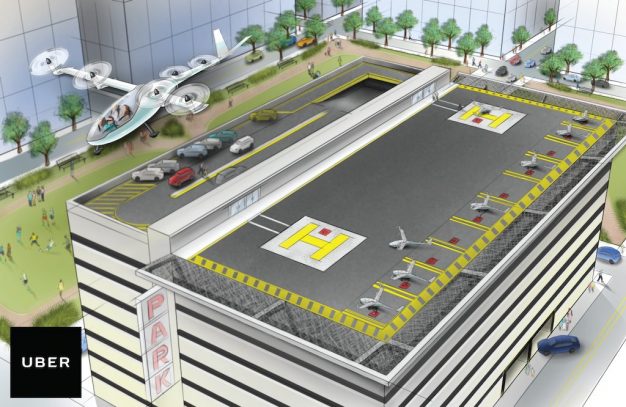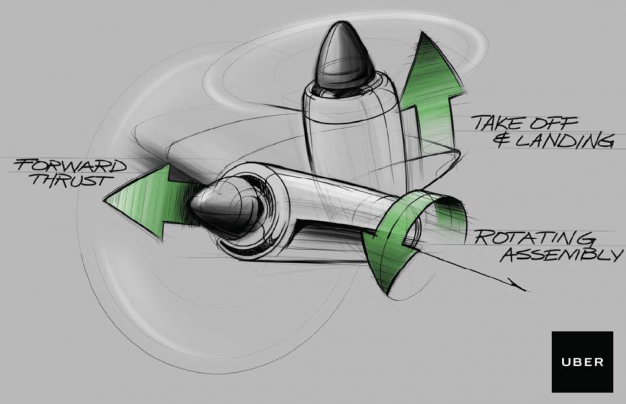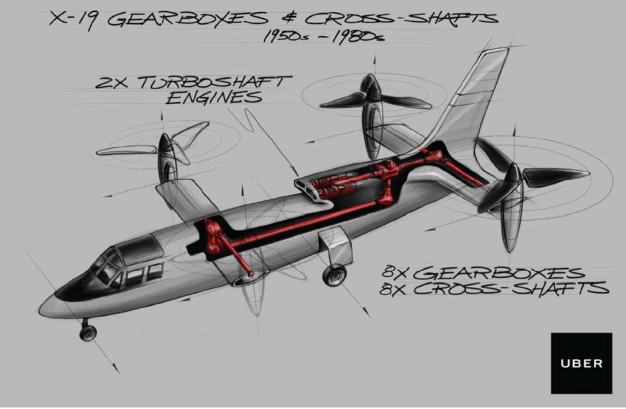 Uber has already revolutionized the way many Americans get across town. But, of course, Uber cars are mired in the same gridlock as all other cars. As some have noted, the ride-sharing service could even be making traffic worse. Yet Uber is drawing up some big plans to take that very two-dimensional traffic problem and open it up to three dimensions—with flying cars.
Uber has already revolutionized the way many Americans get across town. But, of course, Uber cars are mired in the same gridlock as all other cars. As some have noted, the ride-sharing service could even be making traffic worse. Yet Uber is drawing up some big plans to take that very two-dimensional traffic problem and open it up to three dimensions—with flying cars.
–
Hold that snicker. Yes, we know flying cars have been just beyond the horizon for nearly as long as airplanes and cars have existed. But consider this: The company sees as the solution drone-like electric copters—more precisely, so-called VTOL (Vertical Takeoff and Landing) aircraft. With fixed wings and a tilt-rotor arrangement, they’d use helipads for takeoff and landing, with rotors switching the vehicle’s operation to a more conventional winged airplane mode once they’ve climbed more than 1000 feet.
–
 The company already has a name for the service, of course—Uber Elevate—and it’s examined in a 98-page white paper from the technology company detailing how it might achieve that, contextualized through a post from Uber’s chief product officer, Jeff Holden.
The company already has a name for the service, of course—Uber Elevate—and it’s examined in a 98-page white paper from the technology company detailing how it might achieve that, contextualized through a post from Uber’s chief product officer, Jeff Holden.
–
Uber noted that, unlike helicopters, they won’t be reliant on a single part to stay airborne or stable, and the autonomous technology would reduce or eliminate instances of operator error. The tech company plans to use pilots at first, but over the long range it’s also—naturally—targeting autonomous operation.
–
Uber isn’t looking to get into the aircraft-building business, but it expresses hopes that its vision and commitment will be enough to get companies that are capable of engineering such a vehicle on board. FAA certification could be one of the biggest hurdles—more so than the technology itself, or viable manufacturing. They’d also be dependent on the more advanced, next-generation air-traffic-control system; and then there’s the massive infrastructure requirement of providing helipad space, as well as equipping those helipads with the level of commercial-duty fast-charging capable of keeping these vehicles’ high-capacity battery packs charged.
–
 Uber targets a service that could be used daily, not just as a cheaper alternative to renting a helicopter. The company cites the rapid progress of battery packs and the relatively low two miles per kilowatt-hour claimed by the Cirrus SR-22, a four-passenger aircraft, as groundwork for feasibility (although perhaps with broader use of a larger vehicle like the U.S. military’s X-19, shown above). And it arrives at a surprising point: “We also believe that in the long term, VTOLs will be an affordable form of daily transportation for the masses, even less expensive than owning a car.”
Uber targets a service that could be used daily, not just as a cheaper alternative to renting a helicopter. The company cites the rapid progress of battery packs and the relatively low two miles per kilowatt-hour claimed by the Cirrus SR-22, a four-passenger aircraft, as groundwork for feasibility (although perhaps with broader use of a larger vehicle like the U.S. military’s X-19, shown above). And it arrives at a surprising point: “We also believe that in the long term, VTOLs will be an affordable form of daily transportation for the masses, even less expensive than owning a car.”
–
- –
- Two Studies Show Disruptive Impact of Uber and Others Is Minimal
- Uber Employing Drones to Display Ad Messages to Drivers in Traffic Jams
- Volvo and Uber Partnering to Build Autonomous XC90s, Plans to Test Fleet in Pittsburgh
–
–
–
–
If Uber and the like are turning the United States into a nation of passengers rather than drivers, the company’s flying-drones idea could take us out of cars entirely. But for those of us who still want to drive, imagine how much less traffic there would be.
–




